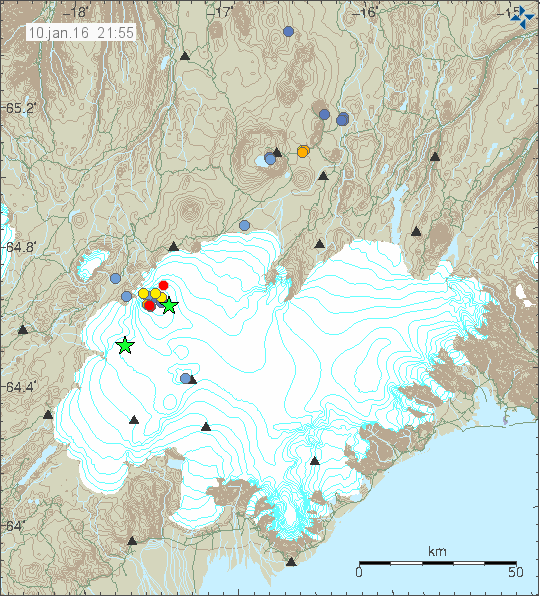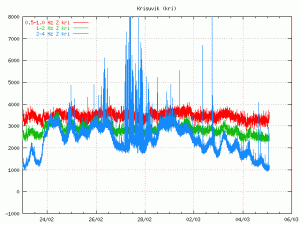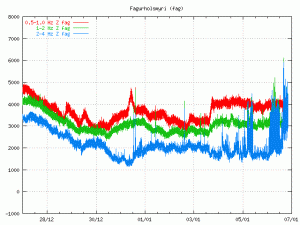Current earthquake activity in Bárðarbunga volcano is going to be a regular feature until next eruption. Due to that I won’t write about all the earthquakes that happens, just when a magnitude 3,0 or larger earthquakes take place. The situation in Bárðarbunga volcano and nearby areas is getting more complex due to increasing magma activity at depth and surprising high number of them are creating pathways to the shallow crust. Since the eruption in Holuhraun ended there has been increase in earthquake activity in Bárðarbunga volcano, this is best seen by almost weekly magnitude 3,0 or stronger earthquakes. What has also been appearing over the past few weeks is deep activity in Trölladyngja, activity that started on 28 km depth and up to 20 km depth currently. That process only took around 1,5 – 2,5 months to happen (short amount of time). The activity in Trölladyngja is troubling in my view, since it’s my opinion that if the magma manages to create a pathway to the surface it is going to start an eruption in that area. Magma below Trölladyngja might also stop in it’s track, if it gets close enough to the surface without eruption it might create a new hill or new hydrothermal area while it’s cooling down. Whatever happens in the end is going to be interesting.

Latest earthquake activity in Bárðarbunga volcano. Copyright of this image belongs to Iceland Met Office.
The second issue that is now starting to show it self is Loki-Fögrufjöll volcano, also known as Hamarinn. Today a magnitude 3,2 earthquake took place in it, not far from Skaftárkötlum cauldrons, the depth was 0,7 km. The earthquake today in Bárðarbunga volcano also had the magnitude of 3,2 with the depth of 0,1 km. Loki-Fögrufjöll volcano is a complex volcano with shallow magma chambers. After the last glacier flood it was clear that hydrothermal activity in Skaftárkatlar cauldrons is increasing the hydrothermal areas are growing in size. This means there is more energy flowing into the hydrothermal systems and the only way that happens if new hotter magma into the volcano. This development is troubling, both in short term and long term. This increases the risk of minor eruption in Loki-Fögrufjöll volcano considerable in my view. Risk of larger eruption in Loki-Fögrufjöll volcano has also gone up. Last eruption in Loki-Fögrufjöll volcano that was large took place in the year 1910 and lasted from June to October that year. Last minor eruption in my view took place in July 2011, lasting for few hours. That eruption has not been confirmed by geologists yet, I don’t know why that is. A glacier flood followed that eruption.
Other complexities in all of this are random fissures that might open up under unknown dykes, starting a eruption in areas that might not have seen a eruption in a long time. Along with new magma dykes going somewhere new. Whatever happens it is going to be interesting and this is going to take a long time. It takes Bárðarbunga volcano, since it starts it eruption cycle up to 20 years to finish once it’s started. The eruption cycle that started in 1862 did not end until 1910. A new eruption cycle started in 2014 and it’s ongoing. The longest eruption cycle I see in GVP data is a eruption cycle that started in 1697, it didn’t end until the year 1797.
Hekla volcano
A single earthquake with the magnitude of 1,7 took place in Hekla volcano today. Nothing else happened following this earthquake. This means Hekla volcano remains quiet.
Frost quakes
It’s cold now in Iceland. This means frost quakes have been appearing on Iceland Met Office SIL stations. This has also been increasing the noise levels on some SIL stations (the blue band when seeing harmonic tremor levels).
History of eruptions in Iceland
I’ve added a short link to a post that a made back in 2011 and I continue to update. This post has all of the eruptions in Iceland since the year ~900. This is good for people that want to check for historical eruptions in Iceland.
Article updated at 00:25 UTC on 11-January-2016. Updated for slight increase in clarity of wording.


